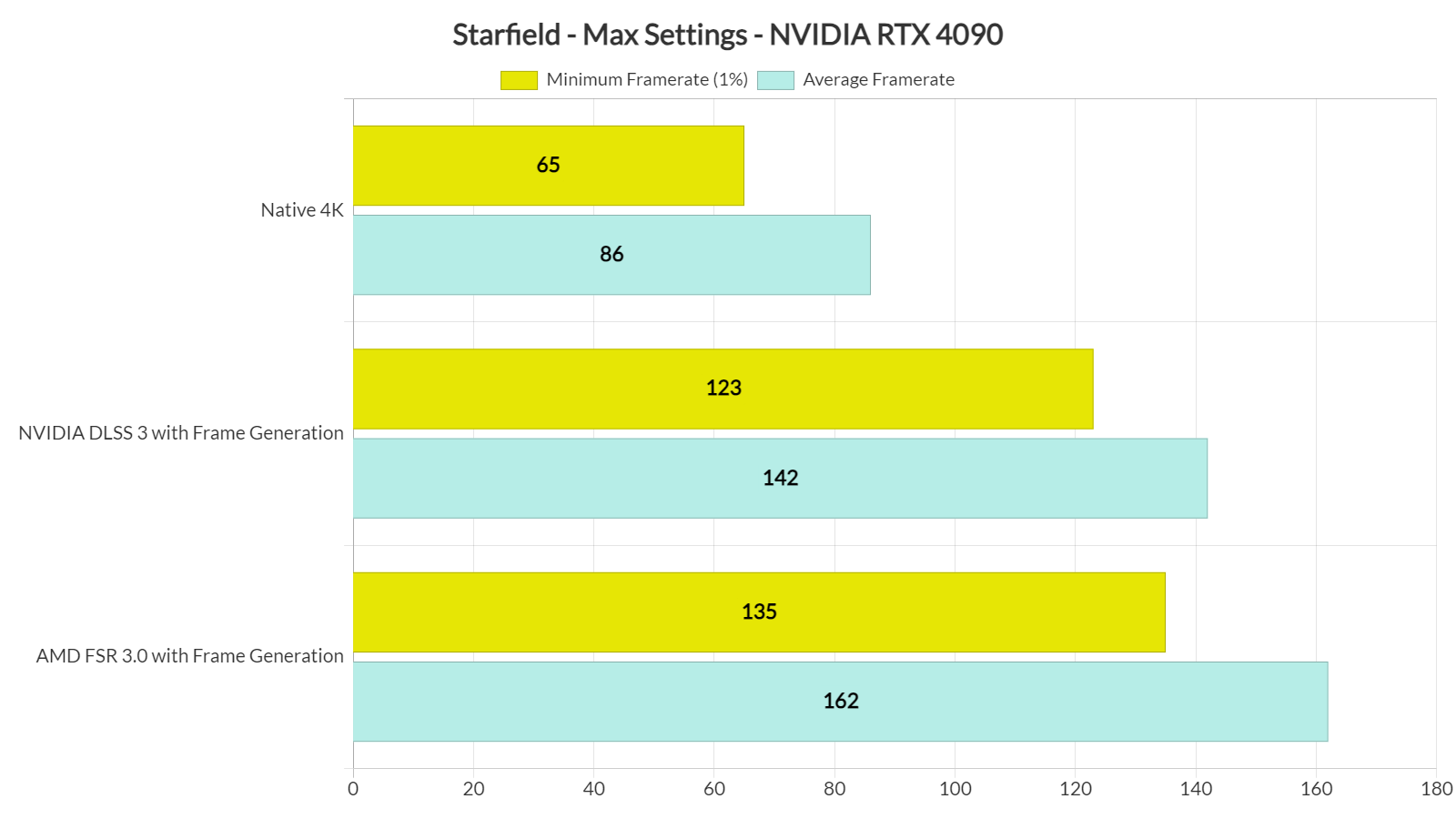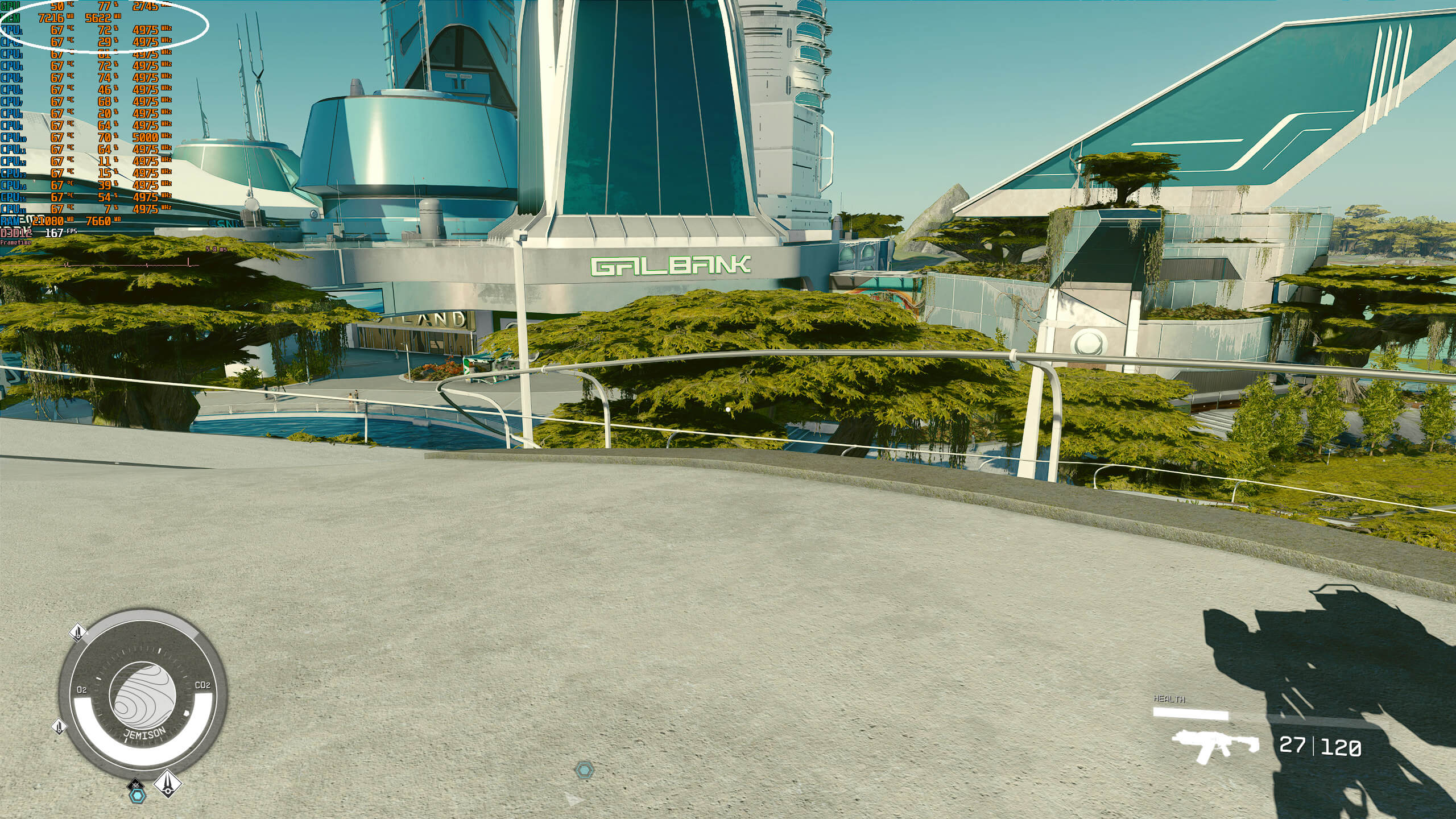A few days ago, Bethesda released a new beta patch for Starfield that added official support for AMD FSR 3.0. As such, we’ve decided to benchmark it and compare it against NVIDIA DLSS 3. Can AMD’s Frame Generation solution compete with the one from NVIDIA? Time to find out.
For our benchmarks, we used an AMD Ryzen 9 7950X3D, 32GB of DDR5 at 6000Mhz, and NVIDIA’s GeForce RTX 4090. I also used Windows 10 64-bit, and the GeForce 551.23 driver. Moreover, I’ve disabled the second CCD on our 7950X3D.
Starfield does not feature any built-in benchmark tool. So, for our tests, we used New Atlantis in Planet Jemison. From what we’ve seen, this is one of the most demanding areas in the game. As such, it should give us a pretty good idea of how the rest of the game performs.
Without any upscaling techniques, the NVIDIA RTX 4090 is able to push a minimum of 65fps and an average of 86fps at 4K/Max Settings. By using DLSS 3 with Frame Generation, we were able to get above 120fps at all times. And then, by enabling FSR 3.0 Frame Generation, we got framerates higher than 130fps.
Sadly, we could not benchmark 1080p or 1440p resolutions. For some reason, DLSS 3 was locking the framerate to our monitor’s refresh rate (165). Here’s a screenshot at 1440p. As you can see, the framerate is locked and the GPU is not maxed out.
Now what’s interesting here is that Starfield is yet another game in which FSR 3.0 Frame Generation offers better performance than DLSS 3 Frame Generation. The performance gap is smaller than the one we saw in Like a Dragon: Infinite Wealth. Still, this is a big win for the red team.
I also could not feel the additional input latency. This is to be expected as we were running with over 120fps at all times. So, perhaps things may differ for those who cannot hit such high framerates. Mouse movement also felt great, though there were some slight stutters with AMD FSR 3.0 here and there. These stutters were nowhere close to those of Avatar: Frontiers of Pandora. Still, despite its lower framerate, DLSS 3 Frame Generation felt more consistent with better frametimes.
Sadly, though, AMD’s FSR 3.0 Super Resolution is inferior to DLSS 3 Super Resolution. FSR 3.0 is simply unable to reconstruct a lot of details, resulting in a lot of aliasing on numerous surfaces. At the end of the video, I highlight this issue. It really looks bad.
So, while AMD FSR 3.0 Frame Generation offers superior performance to NVIDIA DLSS 3 Frame Generation, it gets dragged down by the average image quality of its upscaler. AMD needs to overhaul its Super Resolution tech now that FSR 3.0’s Frame Generation works this well. Otherwise, there is literally no point enabling it if you have an RTX40 series GPU.
For owners of older GPUs, this is a bit more complicated. On one hand, you can increase your performance and AMD FSR 3.0 Frame Generation is doing a great job here. On the other hand, AMD FSR 3.0 Super Resolution is nowhere close to the quality of NVIDIA DLSS 3 or even Intel XeSS, meaning that you’ll get a worse image quality. And no, you cannot use FSR 3.0 FG with NVIDIA DLSS or with Intel XeSS.
This is funny really because a lot of PC gamers were criticizing DLSS 3 for its “fake frames”. A lot of people were also pausing videos to highlight its visual artifacts. So, will the same people enable AMD FSR 3.0 to improve performance and suffer from major image quality issues? Isn’t image quality more important than “fake frames”? That’s food for thought.

John is the founder and Editor in Chief at DSOGaming. He is a PC gaming fan and highly supports the modding and indie communities. Before creating DSOGaming, John worked on numerous gaming websites. While he is a die-hard PC gamer, his gaming roots can be found on consoles. John loved – and still does – the 16-bit consoles, and considers SNES to be one of the best consoles. Still, the PC platform won him over consoles. That was mainly due to 3DFX and its iconic dedicated 3D accelerator graphics card, Voodoo 2. John has also written a higher degree thesis on the “The Evolution of PC graphics cards.”
Contact: Email



